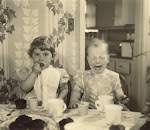Anniversary Day, 1908
Reading about growing up in Brooklyn early in the 20th century reveals two children's holidays that must have been part of the Valentine/McNally children's annual calendar.
Clinton Avenue, Anniversary Day, 1900
The corner may be Greene Avenue, looking north
Elizabeth Valentine and daughter-in-law Teresa, 1934
What the many Catholic parents in Brooklyn thought about a parade celebrating the Protestant Sunday Schools hasn't been recorded.
Another view of Anniversary Day on Clinton Street in June, 1910
Blogger Barry Popik wrote this:
Although in an 1893 account schoolchildren were expected to say "Christian things" about their teachers, there is no indication that children whose families followed other faiths were excluded from the celebrations, which included parades and banners.
Campfire Girls on Anniversary Day 1920
From the Library of Congress collection
Anniversary Day 1943
Another name for the holiday was Rally Day. As mid-20th-century governments became more sensitive about separation of church and state, the name was changed to Brooklyn Day and then Brooklyn/Queens Day. Now it seems to be what we in Kansas would call an In-service Day. Kids get the day off and teachers use it for planning. And some kids still parade.
Read more about Anniversary Day by clicking here:
http://www.barrypopik.com/index.php/new_york_city/entry/brooklyn_queens_day/
Thanksgiving morning 1933
Courtesy of the New York Public Library
Another children's holiday was Thanksgiving, which Brooklynites celebrated in a unique fashion. In A Tree Grows in Brooklyn, a fictional/autobiographical account of a Brooklyn Irish family published in 1943, Betty Smith says this:
"Most children brought up in Brooklyn before the first World War remember Thanksgiving Day there with a peculiar tenderness. It was the day children went around 'ragamuffin' or 'slamming gates,' wearing costumes topped off by a penny mask. ...The street was jammed with masked and costumed children making a deafening din with their penny tin horns. Some kids were too poor to buy a penny mask. They had blackened their faces with burnt cork. Other children with more prosperous parents had store costumes: sleazy Indian suits, cowboys suits and cheesecloth Dutch maiden dresses....Some storekeepers locked their doors against them but most of them had something for the children...[We] went home to a good Thanksgiving dinner of pot roast and home-made noodles and spent the afternoon listening to papa reminisce how he had gone around Thanksgiving Day as a boy."It sounds like Halloween on Thanksgiving morning. I do remember my mother often telling me I looked like a ragamuffin. Based on what I looked like, a ragamuffin meant a girl with her shirt untucked from her skirt and tangles in her hair. There might be more to it than that picture. My guess now is that I looked like a person who was wearing clothes that were too big for her.
Ragamuffins 1933
See more about Thanksgiving and ragamuffins by clicking here
http://www.nypl.org/blog/2010/11/23/thanksgiving-ragamuffin-parade
http://www.greenpt.com/anytngftkg.htm
http://www.flickr.com/photos/eabdesigns/4133615073/
There is some thought that the Macy's Thanksgiving Day Parade was a way of wrestling a folk celebration away from the street and instituting commercial control and order. Children in Brooklyn still march in costume, however, on Thanksgiving morning in their own parade.













Hello, extended family! Jaime Taylor here, Lorraine's daughter/Jack's granddaughter.
ReplyDeleteI've been having myself a chuckle over some of the Brooklyn posts recently, as I just moved to Brooklyn (Bed-Stuy) myself. It's a little ironic, as our parents and grandparents all fled the city for the suburbs, and now all us youngsters are running the other direction, back to the city. Brooklyn is very popular among 20-something such as myself, as it's got nice old neighborhoods, and is convenient to Manhattan but has a lower cost of living.
Thank you so much for posting the rag-a-muffin pictures. My mother used to tell me about "going rag-a-muffin" when she was a little girl in the 1920s.
ReplyDelete